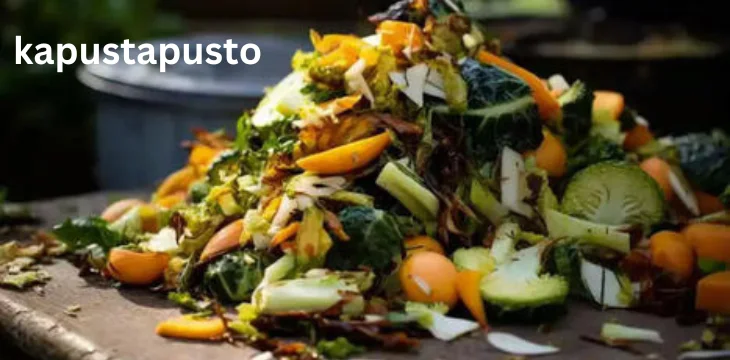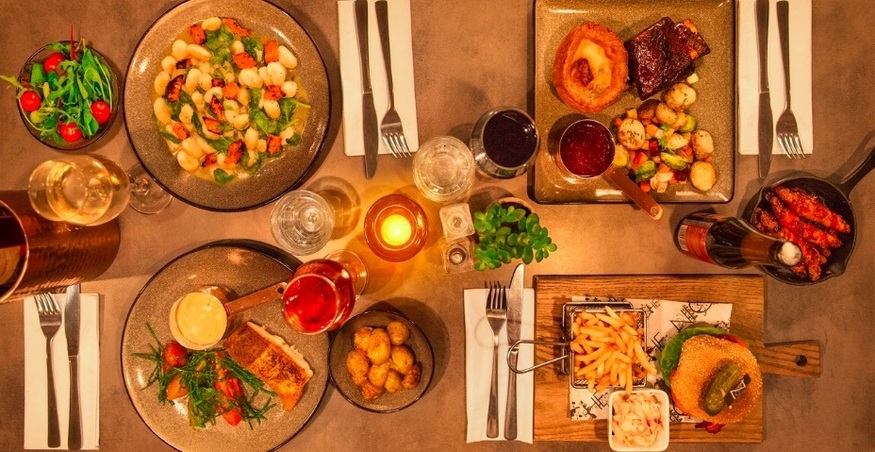foods
Kapustapusto: A Glimpse into Tradition and Taste

The word “kapustapusto,” which some may find foreign, actually describes a lowly but adaptable vegetable with a long history and cultural value. We’ll explore this fascinating food item’s history, nutritional benefits, culinary applications, and much more in this post.
Origins and History
Early mentions
Originating in prehistoric times, kapustapusto was prized for its easy cultivation and nutritious qualities. Centuries-old records point to its widespread occurrence in many societies throughout the world.
Cultural significance
Kapustapusto has been a staple in many cuisines throughout history, signifying good health, wealth, and nourishment. Because of how well it cooked, it became a common element in many traditional cuisines.
Nutritional Value of Kapustapusto
Vitamins and minerals
Packed with vital vitamins like C, K, and folate as well as minerals like calcium, potassium, and manganese, kapustapusto is a nutritional powerhouse. These nutrients support vitality and general well-being.
Health benefits
There are numerous health advantages to eating kapustapusto, including as improved digestion, increased immunity, and help with weight management. Its anti-oxidant qualities also help lower the chance of developing chronic illnesses.
Culinary Uses
Traditional dishes
Kapustapusto is a common ingredient in traditional cuisines across many countries, including rolls, soup, and salads. These recipes highlight the flavour profile and adaptability of the vegetable.
Modern recipes
The emergence of fusion cuisine and culinary exploration has led to the use of kapustapusto into contemporary recipes, such as tacos, smoothies, and desserts. It is a favourite of both home cooks and chefs due to its mild flavour and crisp texture.
Growing Kapustapusto
Ideal conditions
Cool regions with well-drained soil and lots of sunshine are ideal for kapustapusto growth. Healthy growth and development depend on appropriate spacing and adequate irrigation.
Harvesting techniques
When harvesting kapustapusto, mature heads must be carefully chosen, then chopped from the stem using sharp knives. Maximum freshness and flavour are ensured by careful handling and storage.
Regional Variations
Different preparations worldwide
Different preparations are used for kapustapusto depending on the region, which reflects regional culinary customs and tastes. Every version offers a different culinary experience, from fermented Kapustapusto in Asia to pickled Kapustapusto in Eastern Europe.
Popular in various cuisines
Worldwide, kapustapusto has left its mark on culinary traditions ranging from classic European fare to cutting-edge fusion recipes. Chefs and culinary fans throughout the world are still inspired by its adaptability and variety.
Kapustapusto in Popular Culture
References in literature and media
As a sign of plenty, energy, and sustenance, Kapustapusto has been mentioned frequently in literature, art, and the media. Its importance in society is highlighted by its inclusion in cultural narratives.
Symbolism and metaphors
Beyond its culinary applications, kapustapusto represents development, resiliency, and metamorphosis. Its journey from seed to table evokes notions of rebirth and sustenance, reflecting the human experience.
Health Implications
Side effects and precautions
Although kaustapusto has many health advantages, some people may experience allergic responses or digestive problems if they consume too much of it. When consuming Kapustapusto as part of a balanced diet, moderation is key.
Moderation in consumption
When introducing Kapustapusto into your diet, moderation is crucial, just like with other meal. Eating a range of fruits and vegetables guarantees a nutrient-dense diet and enhances general health and wellbeing.
Sustainability and Environmental Impact
Farming practices
The long-term viability of Kapustapusto production is contingent upon the implementation of sustainable agricultural practices. Reduced environmental effect can be achieved by techniques including crop rotation, organic farming, and water conservation.
Eco-friendly alternatives
Further lowering the carbon footprint of kapustapusto agriculture can be accomplished by investigating environmentally friendly substitutes for conventional farming techniques, such as hydroponics and vertical farming. Adopting an innovative mindset is crucial to advancing agricultural sustainability.
Future Trends
Rising popularity
Demand for nutrient-rich veggies like kapustapusto is predicted to climb as customers get more ecologically concerned and health-conscious. Opportunities for innovation and expansion in the agriculture sector are presented by this development.
Innovations in Kapustapustos products
The market for products developed from kapustapustos is ripe for innovation, ranging from value-added items like chips and snacks to plant-based meat substitutes. These products address changing dietary trends and consumer preferences.
Conclusion
To sum up, kapustapusto is a unique vegetable with a long history and cultural importance that is both healthful and flexible. From its culinary uses in modern times to its roots in ancient civilizations, kapustapustos never fails to pique palates and stimulate culinary innovation. Looking ahead, adopting sustainable agricultural methods and investigating cutting-edge product development will guarantee that Kapustapustos continues to be a beloved ingredient in kitchens around.
FAQs:
- Is Kapustapustos suitable for all dietary preferences?
- Yes, Kapustapustos is a versatile vegetable that can be incorporated into various dietary preferences, including vegan, vegetarian, and omnivorous diets.
- Are there any alternative names for Kapustapustos?
- Depending on the region, Kapustapustos may be known by different names. Common alternative names include cabbage, colewort, and brassica oleracea.
- Can Kapustapustos be consumed raw?
- Yes, Kapustapustos can be consumed raw in salads or slaws, providing a crisp texture and mild flavor. However, cooking Kapustapustos can enhance its sweetness and tenderness.
- What are some creative ways to use Kapustapustos in cooking?
- Kapustapusto can be used in a variety of dishes, including stir-fries, soups, wraps, and even desserts. Experimenting with different flavor combinations and cooking techniques can yield delicious results.
- Is Kapustapustos easy to grow at home?
- Yes, Kapustapustos is relatively easy to grow at home, requiring minimal maintenance and space. With the right growing conditions and care, you can enjoy a bountiful harvest of fresh Kapustapustos right from your garden.
foods
Cofeemanga: Exploring the Brew of Culture and Tradition

Cofeemanga is a blend of coffee and manga, the Japanese comic books or graphic novels known for their intricate artwork and captivating storytelling. It merges the love for coffee with the vibrant world of manga, creating a sensory experience unlike any other.
History and Origin of Cofeemanga
The concept of Cofeemanga originated in Japan, where coffee culture and manga are deeply ingrained in society. It emerged as a way to combine two beloved aspects of Japanese lifestyle into a single, immersive experience. Over time, Cofeemanga has evolved into a global phenomenon, transcending cultural boundaries.
Benefits of Cofeemanga
Health Benefits
Cofeemanga offers the health benefits associated with coffee consumption, such as increased alertness and improved cognitive function. Additionally, the act of reading manga can reduce stress and promote relaxation, enhancing overall well-being.
Social Benefits
Sharing a cup of Cofeemanga with friends or family provides an opportunity for social connection and bonding. It serves as a conversation starter, fostering meaningful interactions and building relationships.
Cultural Impact
Cofeemanga celebrates the intersection of coffee culture and manga fandom, creating a unique subculture with its own rituals and traditions. It reflects the dynamic nature of cultural exchange in a globalized world.
How to Make Cofeemanga
Ingredients Needed
To make Cofeemanga, you will need freshly brewed coffee and your favorite manga volume.
Step-by-Step Instructions
- Brew a cup of your preferred coffee blend, ensuring it’s hot and aromatic.
- Select a manga volume that matches your mood or interests.
- Find a cozy spot to enjoy your Cofeemanga experience.
- Sip your coffee slowly while immersing yourself in the captivating world of manga.
Popular Varieties of Cofeemanga
Traditional Flavors
Some traditional varieties of Cofeemanga include classic coffee blends paired with popular manga series, offering a nostalgic and comforting experience.
Modern Twists
Modern interpretations of Cofeemanga may incorporate innovative coffee recipes and unconventional manga genres, appealing to a diverse audience with varied tastes.
Cofeemanga and Its Global Influence
Spread Across Continents
Cofeemanga has gained popularity beyond Japan, with enthusiasts around the world embracing this unique blend of coffee and culture.
Fusion with Local Cultures
In different countries, Cofeemanga has been adapted to suit local preferences and traditions, resulting in a rich tapestry of flavors and experiences.
Cofeemanga Rituals and Traditions
Ceremonial Practices
Some cultures have developed specific rituals surrounding the consumption of Cofeemanga, incorporating elements of tea ceremonies or book clubs into the experience.
Celebrations and Festivals
Cofeemanga festivals and events provide opportunities for fans to come together and celebrate their shared passion for coffee and manga, fostering a sense of community and camaraderie.
Cofeemanga in Popular Culture
References in Media
Cofeemanga has made appearances in various forms of media, including movies, TV shows, and literature, reflecting its growing influence on popular culture.
Influence on Art and Literature
Artists and writers draw inspiration from Cofeemanga, incorporating its themes and imagery into their work, thereby perpetuating its cultural significance.
Conclusion
Cofeemanga represents a harmonious blend of coffee and manga, offering a unique sensory experience that transcends cultural boundaries. Its popularity continues to grow, driven by its health benefits, social appeal, and cultural significance. Whether enjoyed alone or shared with others, Cofeemanga embodies the spirit of creativity, community, and connection.
FAQs
- Is Cofeemangas suitable for children?
While Cofeemangas is generally enjoyed by adults, there are child-friendly manga series available for younger audiences to explore under parental guidance. - Can I substitute coffee with tea to make Cofeemangas?
While traditional Cofeemangas uses coffee as its base, you can experiment with different beverages such as tea to create your own unique blend. - Are there any health risks associated with consuming Cofeemangas?
As with any caffeinated beverage, moderation is key. It’s essential to be mindful of your caffeine intake and listen to your body’s signals. - Can I create my own Cofeemangas recipes at home?
Absolutely! Feel free to experiment with different coffee blends, manga genres, and serving styles to create personalized Cofeemangas experiences. - Where can I find Cofeemangas events or communities to join?
Online platforms, social media groups, and local coffee shops often host Cofeemangas-themed events and gatherings. Keep an eye out for announcements and invitations in your area.
foods
Kecveto: Embracing a Healthier Lifestyle

Kecveto is a new lifestyle trend that has evolved in recent years. However, what is Kecveto exactly? The purpose of this article is to examine the history, advantages, methods for use, difficulties, and recipes related to Kecveto.
Kecveto: What is it?
Kecveto is a way of living that places a focus on eating more plant-based meals and reducing or giving up animal products. It pushes people to concentrate on entire, unprocessed foods such grains, legumes, nuts, seeds, fruits, and vegetables.
Kecveto’s past
The notion of Kecveto originates from a number of philosophical and cultural movements that support health, sustainability, and compassion. Though veganism and vegetarianism have been practises for ages, Kecveto is a contemporary interpretation of these ideas.
The Value of the Kecveto
Kecveto holds significance for multiple rationales. It not only enhances individual health and wellbeing but also has important positive effects on the environment and the economy. Kecveto protects natural resources and lessens the harmful effects of animal husbandry on the environment by consuming less animal products.
Advantages of Kecveto for Health
Kecveto’s beneficial effects on health rank among its main advantages. Plant-based diets have been linked to a lower risk of chronic illnesses like diabetes, heart disease, and some types of cancer, according to research. Kecveto can also aid with weight loss, boost energy levels, and enhance digestion.
Advantages for the Environment
Kecveto aids the environment as well. Deforestation, water pollution, and greenhouse gas emissions are all significantly impacted by animal husbandry. Kecveto contributes to a smaller environmental impact from food production by lowering the demand for animal products.
Benefits for the Economy
Adopting a plant-based diet and gradually cutting back on meat, dairy, and eggs can result in long-term cost savings on healthcare related to avoidable diseases. Getting started with a plant-based diet can help individuals and families save money on groceries.
Tips for a Successful Kecveto Lifestyle
- Plan Ahead: Take time to plan your meals and snacks to ensure you have plenty of nutritious options on hand.
- Read Labels: Pay attention to food labels to identify hidden animal products and choose products that are certified vegan.
- Seek Support: Join online communities or local groups of like-minded individuals for support and inspiration on your Kecveto journey.
Challenges of Kecveto
Social Acceptance: One of the most significant obstacles to following a plant-based diet is navigating social situations where eating out and attending parties with animal products is customary. Nevertheless, with persistence and clear communication, these situations can be managed while adhering to one’s moral principles. Practical Challenges: Another challenge associated with the Kecveto diet is the practical aspect of meal planning and preparation.
Overcoming Obstacles
It’s critical to experiment with new recipes, learn about nutrition, and have an adaptable mindset in order to overcome these obstacles. It’s okay to bring your own food to social gatherings and ask for substitutes at restaurants.
Kecveto Recipes
Breakfast Recipes
- Avocado Toast: Top whole grain toast with mashed avocado, sliced tomatoes, and a sprinkle of salt and pepper.
- Smoothie Bowl: Blend frozen berries, banana, spinach, and almond milk until smooth, then top with granola and sliced fruit.
Lunch Recipes
- Quinoa Salad: Combine cooked quinoa with diced vegetables, chickpeas, and a lemon-tahini dressing.
- Stuffed Bell Peppers: Fill halved bell peppers with cooked rice, black beans, corn, and salsa, then bake until tender.
Dinner Recipes
- Vegetable Stir-Fry: Sauté tofu, broccoli, bell peppers, and carrots in a savory sauce, then serve over brown rice.
- Spaghetti Squash Pad Thai: Roast spaghetti squash until tender, then toss with a sauce made from peanut butter, lime juice, and soy sauce, and top with chopped peanuts and cilantro.
Snack Recipes
- Hummus and Veggie Sticks: Serve store-bought or homemade hummus with sliced cucumbers, carrots, and bell peppers.
- Trail Mix: Mix together nuts, seeds, dried fruit, and dark chocolate chips for a satisfying snack on the go.
Conclusion
Kecveto, in summary, has a lot to offer the economy, the environment, and human health. People can both benefit the environment and their own health by adopting a plant-based lifestyle. Despite possible obstacles in the path, achieving Kecveto can be a gratifying and rewarding experience with commitment and perseverance.
FAQs
What is the origin of the term “Kecveto”?
The term “Kecveto” is derived from the combination of “ke” for key, “cve” for cultivate, and “to” for total, reflecting its emphasis on cultivating a healthy lifestyle.
Is Kecveto suitable for everyone?
While Kecveto can be beneficial for many people, individual dietary needs vary. It’s important to consult with a healthcare professional before making any significant changes to your diet.
Can Kecvetos be expensive to maintain?
While some specialty plant-based products can be expensive, a Kecvetos diet can be affordable by focusing on whole, minimally processed foods such as grains, legumes, and produce.
How can one ensure they are getting enough nutrients on a Kecvetos diet?
Eating a varied diet that includes a wide range of fruits, vegetables, whole grains, and legumes can help ensure you get all the nutrients you need on a Kecvetos diet. Consider consulting a registered dietitian for personalized guidance.
Are there any potential risks associated with Kecvetos?
While Kecvetos can be a healthy choice for many people, it’s important to ensure you’re meeting your nutritional needs, particularly for nutrients like vitamin B12, iron, and omega-3 fatty acids. Again, consulting with a healthcare professional is recommended.
foods
Gluten-Free Restaurants: Catering to a Growing Need

The desire for healthy eating habits, combined with a greater understanding of celiac disease and gluten intolerance, has led to a rise in the popularity of gluten-free diets in recent years. Consequently, there is an enormous increase in the demand for gluten-free dining options, which has caused specialty restaurants that serve this dietary niche to arise.
Knowing About Gluten and Its Impacts
Protein called gluten, which is present in wheat, barley, and rye, is frequently added to food goods to give them structure and flexibility. However, eating gluten can cause negative effects, such as exhaustion, neurological symptoms, and digestive problems, in people with celiac disease or gluten sensitivity.
The Growth of Restaurants Without Gluten
A recent global trend of gluten-free restaurants has arisen as a result of the realisation that people with gluten-related diseases must be accommodated. Providing satisfying and safe dining experiences for individuals on gluten-free diets is a top priority for many venues.
Advantages of Gluten-Free Dining Establishments: Enhanced Digestive Health
Eating gluten can cause acute stomach pain and long-term health issues in people with celiac disease or gluten sensitivity. Customers can enjoy meals in a safe refuge without worrying about negative reactions at gluten-free establishments.
More Options on the Menu for Dietary Restrictions
Beyond only removing gluten-containing products, gluten-free restaurants frequently provide dairy-free, vegan, and paleo menu items in addition to other dietary restrictions. Its inclusivity guarantees that people with different dietary requirements can find satisfying meals.
Meeting the Needs of an Expanding Market
The need for gluten-free dining options has increased dramatically as knowledge of gluten-related illnesses grows. Taking advantage of this growing market, gluten-free eateries are drawing patrons who are looking for tasty, nutritious, and safe meals.
Difficulties in Running Gluten-Free Restaurants: Sourcing Ingredients and Ensuring Quality
To avoid cross-contamination, maintaining a gluten-free kitchen necessitates close attention to ingredient sourcing and quality control. To guarantee the safety of their gluten-free menu items, restaurant operators need to carefully select their suppliers and have strict policies in place.
Risks of Cross-Contamination
Because even minute amounts of gluten can cause negative reactions in sensitive people, cross-contamination is a major concern in gluten-free eateries. Ensuring the integrity of gluten-free dishes and reducing the likelihood of cross-contamination need stringent kitchen procedures and employee education.
Staff Education and Training
It is imperative to guarantee that all personnel had adequate knowledge regarding gluten-related illnesses and the significance of following gluten-free procedures. The restaurant team’s culture of awareness and accountability is fostered by ongoing education and training.
Essential Elements of Restaurants Without Gluten
A Specialised Gluten-Free Menu
The distinguishing feature of gluten-free restaurants is their extensive menu, which offers patrons a plethora of options. These menus make it apparent which foods are gluten-free, and for transparency’s sake, they might also provide extra information about other allergies.
Tight Kitchen Guidelines
To keep gluten-free ingredients pure and avoid cross-contamination, gluten-free eateries follow strict cooking procedures. Gluten-free kitchens typically follow specific cleaning protocols, set apart prep areas, and use separate cooking tools.
Verification and Validation
Certain gluten-free eateries go through certification or accreditation procedures as a sign of their dedication to offering reliable and secure dining experiences. For these certificates, third-party audits and evaluations to guarantee adherence to gluten-free guidelines may be required.
Well-known Gluten-Free Dining Establishments Worldwide
Many gluten-free eateries have won praise in recent years for their commitment to flavour, quality, and creativity. These venues, which range from quaint cafés to elegant restaurants, tempt not only gluten-free eaters but also foodies with their wide selection of gluten-free treats.
Advice for Researching and Preparing Gluten-Free Food When Eating Out
It’s important to read up on the menu, reviews, and gluten-free policies of a restaurant before dining there. Making preparations in advance enables customers to make wise decisions and guarantees a fun and safe dining experience.
Talking with Restaurant Staff
Having open lines of contact with restaurant staff is essential to successfully navigate the gluten-free dining scene. Asking questions about ingredients and preparation techniques and disclosing specific dietary requirements to servers will assist to clear any confusion and guarantee that food is cooked safely.
Keeping Cross-Contamination in Mind
Cross-contamination can happen even at gluten-free establishments that make a concerted effort to uphold stringent gluten-free procedures. To reduce the chance of unintentionally exposing themselves to gluten, patrons should exercise caution and let restaurant employees know about any concerns or dietary requirements.
The Future of Technological Advancements in Gluten-Free Food
Technological innovations, like gluten-detecting gadgets and applications, are completely changing how people navigate gluten-free dining. With the help of these resources, consumers can confidently advocate for their dietary needs and make well-informed decisions.
Shifting Consumer Preferences
We should anticipate a rise in the number of major restaurants and food enterprises providing gluten-free options as the demand for these options keeps rising. This change is a reflection of changing consumer tastes for inclusive, healthier dining experiences.
Conclusion
In order to provide people with gluten-related diseases with inclusive, delectable, and safe dining options, gluten-free restaurants are essential. By putting quality, creativity, and customer pleasure first, these restaurants are changing the food scene and meeting the increasing demand for gluten-free dining.
-

 news5 months ago
news5 months agoTaylorville Daily News: A Beacon of Local Information
-

 pets7 months ago
pets7 months agoCraigslist Boise Pets: Finding Your Furry Companion in Idaho’s Capital
-

 fashion6 months ago
fashion6 months agoAcubi Fashion
-

 pets7 months ago
pets7 months agoExploring Santa Rosa, NM with Your Furry Friend: Pet-Friendly Hotels Await!
-

 sports6 months ago
sports6 months agoSportsurge College Football
-

 news7 months ago
news7 months agoBriteBet News: Stay Informed with the Latest Updates
-

 general6 months ago
general6 months agoKikk Bar Vape: A Convenient and Flavorful Vaping Experience
-

 sports5 months ago
sports5 months ago93 sundrop ln crossville tn to toqua sports bar distance
